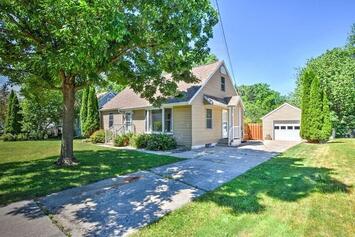
In March I bought a modest, two-bedroom 1950 tract house in Madison, Wisconsin. It’s not going to win any awards for cutting-edge design, but it’s solid, respectable, and in a safe, quiet neighborhood with a premium school district. It’s a few blocks walk to the lake and a couple of public parks with picnic areas, boat launch, and the beach. A few blocks in the opposite direction there’s a suburban strip with the quotidian essentials: grocery store, bank, post office, churches, hardware store, and so on. Kids from elementary to high school can walk to class if families are so inclined. On a perfect day in June it’s even possible to ride a bicycle around the lake to downtown in half an hour, in a more or less safe and pleasant manner. And this particular house is one of the smallest properties in the neighborhood, bordered on the back by much larger more expensive homes on bigger, three-quarter acre lots. It’s the classic “worst house in a great location.”
I’ll be honest and say this isn’t my dream property. For those of you familiar with Madison, my natural habitat is more like Willy Street on the near east side of the city. It’s not exactly downtown, but one of the smaller close-in Main Street-type neighborhoods that were built almost everywhere in North America between the late 1800s and just before World War II. Unfortunately, properties around Willy Street are hard to come by, and this is a particularly competitive time to be shopping for real estate. The place I did buy was selected from the next best options that were available to me at a price I could manage. This place ticked most of the boxes in a cost-effective manner.
Why Madison? I have extended family in nearby Beaver Dam and Adams to the north. The state of Wisconsin has just shy of six million people, but many counties are losing population, with fewer and fewer young people and an aging demographic. Dane County, home to Madison, is one of the few exceptions. It’s been growing by about ten percent per year for a while now. Aside from some infill development in the urban core, almost all that growth is on the suburban periphery.
Basically, if you’re young, well educated, looking for a high quality of life, and committed to staying in Wisconsin rather than migrating away to a big city or the Sun Belt, you tend to move to Madison. Madison is also attracting migrants from places like Chicago and Minneapolis, who are looking for a similar environment at a more manageable scale and reasonable price point. Madison is expensive by Wisconsin standards, but cheap compared to larger places.
Architect Kevin Klinkenberg in Kansas City, Missouri, describes the four kinds of suburbs: rural exurban sprawl, master-planned communities, standard or “late” suburbia, and pre-interstate suburbs. Of these four, the only one that lends itself to a modicum of mixed use and walkability is the pre-interstate suburb, referring to the Federal Aid Highway Act of 1956. These tend to be closer to the center of a metroplex, so they are geographically more accessible, and since they were among the very first auto-oriented developments, they still retain at least some of the qualities of older pedestrian neighborhoods. Since I couldn’t have the kind of older house in the place I preferred, this was a pretty good fallback position.
Read the rest of this piece at Strong Towns.
Johnny Sanphillippo is an amateur architecture buff with a passionate interest in where and how we all live and occupy the landscape, from small rural towns to skyscrapers and everything in between. He travels often, conducts interviews with people of interest, and gathers photos and video of places worth talking about (which he often shares on Strong Towns). Johnny writes for Strong Towns, and his blog, Granola Shotgun.












